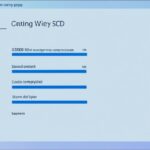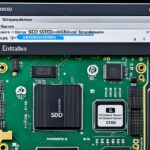Table of Contents
Learning to format an SSD in BIOS is key to boosting your computer’s performance. SSDs use flash technology to save data, which makes them fast and reliable. Sometimes, you might need to wipe your SSD. This could be to reinstall the operating system or fix ongoing problems. Knowing how to format an SSD in BIOS means you can keep your computer running smoothly. For a detailed guide on how to do this, check out this SSD formatting guide.
Key Takeaways
- It’s crucial to know how to format an SSD for better computer performance.
- SSDs are chosen for their quick speed, reliability, and durability across various devices.
- Always back up important files before formatting your SSD to avoid losing data.
- Secure Erase is the best method for formatting SSDs in BIOS safely.
- You can also use software like EaseUS Partition Master to format an SSD.
Understanding SSDs and Their Benefits
Today, as technology changes the way we store and access data, knowing about solid state drives (SSDs) is key. You might ask, what is an SSD? Simply put, SSDs are devices that save your data without needing to move. They use special circuits to do this. This new technology enhances our computing experience by offering benefits not found in older hard drives (HDDs).
What is a Solid State Drive (SSD)?
Unlike HDDs that rely on mechanical parts, SSDs use flash memory for faster file access. This means they’re quicker and less likely to break down over time. They usually use NTFS or exFAT formats, with NTFS being more common for bigger files1. SSDs work best with modern operating systems that support the TRIM command. This keeps them running fast and efficient2.
Advantages of Using an SSD
SSDs are known for their speed, making your computer start up and load apps faster. They are also more durable since they don’t have parts that move and get damaged. But, it’s important to format an SSD properly to avoid harm and extend its life2. The TRIM command also plays a big role. It helps the SSD stay clean by getting rid of data that’s no longer needed, akin to HDD defragmentation2. SSDs improve experiences in gaming and professional content creation.
| Feature | SSD | HDD |
|---|---|---|
| Speed | High read/write speed | Slower read/write speed |
| Durability | No moving parts | Mechanical components susceptible to failure |
| Weight | Lighter | Heavier |
| Noise | Silent operation | Noise generated by moving parts |
| Power Consumption | Lower power consumption | Higher power consumption |
SSDs are becoming more popular in computing. They offer better performance and reliability. This leads to a better digital experience21.
Preparing to Format Your SSD
Before you start the format process for your SSD, make sure to back up your important files. Formatting will erase everything on the SSD. That includes all your crucial data. Creating a solid backup is the key first move. You can backup your data on external drives or use cloud storage to keep your files safe.
Backing Up Important Data
Backing up your files is critical in this digital age. You can use external drives or cloud services to protect your important documents and media. This way, you’ll keep your important data safe and retrievable, even if things go wrong during formatting.
Accessing Your BIOS Settings
After backing up, the next thing is to get into your BIOS settings. You can usually enter the BIOS by pressing a specific key like F2 or Delete as your computer starts. Once in the BIOS menu, you can change settings to get your SSD ready for formatting.
It’s important to set your computer to start from the correct device, like a USB if you’re using it for the installation. Always check the boot settings and make sure they work with your SSD. Some older systems might need you to switch between UEFI and legacy modes34.
How to Format an SSD in BIOS
Formatting an SSD in the BIOS might sound hard, but it’s quite easy if you know how. There are mainly two ways to do it: using the Secure Erase function or getting around the BIOS settings for SSDs.
Using the Secure Erase Feature
The Secure Erase option is a powerful tool for clearing all data on your SSD, making it like new again. It’s really useful when you want to install something fresh or remove personal data safely. Before using it, make sure your SSD works with your motherboard. Many people struggle to format an SSD with an OS on it or on a computer that won’t start. They ask about formatting through the BIOS5. This feature is the answer, allowing for a total clean-out.
Formatting an SSD using BIOS means you need to be comfortable with the BIOS settings. You might have to look around different menus that help you identify, not format, the SSD. Since BIOS setups can vary, knowing your way around yours helps a lot. Sooner or later, you’ll manage to format and organise your SSD the way you need6.
| Method | Duration | Difficulty Level | Effectiveness | Suitable Users |
|---|---|---|---|---|
| EaseUS Partition Master | 5 minutes | Easiest | High | All Users |
| Secure Erase | 7 minutes | Easy | Moderate | All Users |
| Command Prompt | 10 minutes | Hard | Moderate | Seasoned Users |
Getting to know different ways to format helps boost your confidence with SSDs. Once you understand which method fits your skills and system needs, formatting issues become less of a worry7.
Alternative Methods for Formatting an SSD
There are several ways to format an SSD apart from the usual BIOS method. You can use EaseUS Partition Master or command prompt techniques. You might also consider bootable media for SSD formatting. Each option is designed to fit various needs and levels of expertise.
Using EaseUS Partition Master
EaseUS Partition Master stands out for its easy-to-use interface and handy partition management. You can format an SSD in about 5 minutes with this tool. It makes formatting simple7. It is praised for its efficiency and for providing data protection. This is something BIOS formatting might lack7. It suits both beginners and advanced users. This tool ensures a safe formatting process, without harming the SSD7.
Command Prompt and Bootable Media Options
For those who prefer using the command line, try formatting an SSD through the command prompt. While this might take around 10 minutes and is considered harder, it appeals to those skilled in command use7. Another choice is using bootable media for SSD formatting. This way, you can format in a bootable environment. It’s useful when standard tools aren’t an option.
EaseUS Partition Master is known for its ease and speed. Besides being suitable for all user levels, it also offers data migration and disk cloning. If you’re deciding on the best method, a third-party tool like this can make things much easier. It’s great for starting new projects or keeping your system running smoothly with efficiency in mind5.
Conclusion
Knowing how to format an SSD properly is crucial for its performance and life span. This format SSD BIOS guide advises you to always back up important data before starting. This way, you won’t lose any vital information. Whether you’re using the BIOS or tools like AOMEI Partition Assistant Professional for its easy use and complete features, several methods can keep your SSD in top shape58.
BIOS formatting can solve problems like file system corruption and errors in the operating system. It’s a simple process that involves going to storage settings and making changes8. Knowing these methods helps you better understand how to maintain your SSD. It also lets you manage your storage more effectively.
By learning about SSD formatting, you can boost your device’s performance and make it last longer. Following the best tech maintenance practices is key. If you’re keen to dive deeper into computer management, check out resources that offer more advice and tips. You can find them at for effective results and get even more from your SSD.
FAQ
What is the difference between an SSD and an HDD?
SSDs and HDDs differ mainly in how they store and access data. SSDs use integrated circuits, making them faster and more reliable. On the other hand, HDDs use magnetic storage, which is slower and less efficient.
How do I access the BIOS settings to format my SSD?
To get into your BIOS settings, first restart your computer. During boot-up, press a key like F2, F10, DEL, or ESC. In the BIOS, look for storage settings to find the SSD formatting option.
Is it necessary to back up my data before formatting my SSD?
Absolutely. Before you format your SSD, you must back up everything. Formatting clears all the data on your SSD, including important files and photos.
What is the Secure Erase feature and how does it work?
Secure Erase is a feature in many SSDs that fully deletes all data. It resets the SSD to its original state, ensuring no data can be recovered. It’s perfect for when you’re disposing of your SSD or starting fresh.
Can I use software to format my SSD instead of BIOS?
Yes, you can! Software like EaseUS Partition Master offers an easy way to format SSDs. It’s great for those not comfortable with BIOS. These tools also offer extra protections and features.
What should I consider before using command prompt for SSD formatting?
Before using Command Prompt, know your commands well. Any mistake might cause data loss. So, always back up your data first.
Will formatting an SSD improve performance?
Formatting can boost your SSD’s performance by cleaning out old, fragmented data. Though, it’s better to keep your SSD well-maintained regularly, not just through formatting.
What types of SSDs support the Secure Erase feature?
Most SSDs from well-known brands like Samsung, Crucial, and Western Digital have Secure Erase. Always check with your SSD’s manufacturer for detailed instructions and compatibility.
Source Links
- https://www.kingston.com/en/blog/personal-storage/how-to-format-ssd – How to Format Your SSD
- https://www.crucial.com/articles/about-ssd/how-to-format-a-solid-state-drive – How to Format a Solid State Drive (SSD)
- https://www.minitool.com/news/format-ssd-without-os.html – A Detailed Guide: Format SSD Without OS
- https://www.hp.com/us-en/shop/tech-takes/how-to-secure-erase-ssd – How To Secure Erase An SSD Drive | HP® Tech Takes
- https://www.diskpart.com/articles/format-ssd-from-bios-1503.html – [3 Ways] How to Format SSD from BIOS Windows 10
- https://discussion.fedoraproject.org/t/format-installation-on-new-ssd/104984 – Format & installation on new SSD
- https://www.easeus.com/partition-master/how-to-format-ssd-from-bios.html – How to Format SSD From BIOS [Easy & Fast]
- https://www.ubackup.com/articles/how-to-format-ssd-from-bios-7983-ac.html – Guide: How to Format SSD from BIOS








